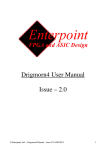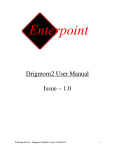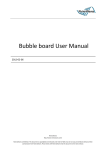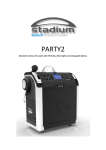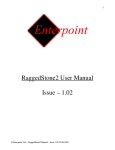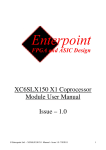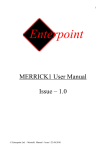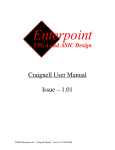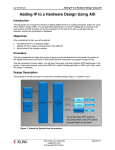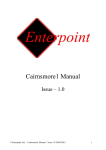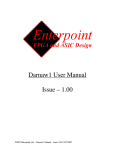Download Drigmorn3 User Manual Issue – 1.0
Transcript
Drigmorn3 User Manual Issue – 1.0 © Enterpoint Ltd. – Drigmorn3 Manual – Issue 1.0 02/03/2010 1 Kit Contents You should receive the following items with your Drigmorn3 development kit: 1 - Drigmorn3 Board 2 - Programming Cable 3- USB lead. Foreword PLEASE READ THIS ENTIRE MANUAL BEFORE PLUGGING IN OR POWERING UP YOUR DRIGMORN3 BOARD. PLEASE TAKE SPECIAL NOTE OF THE WARNINGS WITHIN THIS MANUAL. Trademarks Spartan-6, ISE, Webpack, EDK, COREGEN, Xilinx are the registered trademarks of Xilinx Inc, San Jose, California, US. Drigmorn3 is a trademark of Enterpoint Ltd. © Enterpoint Ltd. – Drigmorn3 Manual – Issue 1.0 02/03/2010 2 Contents Kit Contents Foreword Trademarks Drigmorn3 Board Introduction Getting Started FPGA SPI FLASH DDR3 MEMORY DIL HEADERS USB ETHERNET TOP IDC HEADER LCD DISPLAY LEDS REAL TIME CLOCK POWER MONITOR/MASTER RESET OSCILLATOR SWITCHES SERIAL EEPROM MICRO SD CARD HOLDER ACCELEROMETER PS2 INPUT POWER CONNECTIONS POWER REGULATORS PROGRAMMING DRIGMORN3 MECHANICAL Medical and Safety Critical Use Warranty Support © Enterpoint Ltd. – Drigmorn3 Manual – Issue 1.0 02/03/2010 2 2 2 4 5 6 8 9 10 12 14 16 18 19 21 23 25 26 27 28 29 30 31 33 34 36 39 41 41 41 3 Drigmorn 3 © Enterpoint Ltd. – Drigmorn3 Manual – Issue 1.0 02/03/2010 4 Introduction Welcome to your Drigmorn3 board. Drigmorn3 is Enterpoint’s first Spartan-6 development board. It offers a highly powerful, flexible and low cost approach to prototyping FPGA and System designs. The aim of this manual is to assist in using the main features of Drigmorn3. There are features that are beyond the scope of the manual. Should you need to use these features then please email [email protected] for detailed instructions. Drigmorn3 currently comes with a XC6SLX16-2CSG324CES Spartan-6. Other variants may be offered at a later date or as an OEM product. Spartan-6 parts up to XC6SLX45 can be fitted to this board. Please contact out us on [email protected] should you need further information. Drigmorn3 is supported by a wide range of add-on modules. Some examples of these include: ADC 7927 MODULE LED DOT MATRIX MODULE BUTTONS/SWITCHES/SATA/MEMORY MODULE RS232 AND RS485 HEADER MODULES DP83816 ETHERNET MODULE SD CARD MODULE DDR2 MODULE IDE/5V TOLERANT CPLD MODULE USB MODULE D/A CONVERTER MODULE ADV70202 MODULE We can also offer custom DIL Header modules should you require a function not covered by our current range of modules. Typical turn around for this service is 6-8 weeks depending upon quantity ordered and availability of components. © Enterpoint Ltd. – Drigmorn3 Manual – Issue 1.0 02/03/2010 5 Getting Started 20 IOs on IDC HEADER 4 WAY DIP SWITCH 2X16 LCD DISPLAY SPARTAN-6 FPGA 5V PICK UP HEADER 2 PUSH BUTTON SWITCHES 13 LEDs REAL TIME CLOCK DN1306EN ETHERNET INTERFACE 1GBIT DDR3 MEMORY 16KBIT EEPROM USB INTERFACE 128M FLASH MEMORY BATTERY HOLDER FOR REAL TIME CLOCK DIL HEADERS WITH FORTY 5V TOLERANT IO MICRO SDCARD HOLDER (ON BACK OF BOARD JTAG CONNECTOR RJ45 CONNECTOR ACCELEROMETER MINI USB CONNECTOR TWO PS2 PORTS Your Drigmorn3 will be supplied un-programmed. Unless you have bought an OEM product your board will be supplied with either a Prog2 parallel port programming cable or a Prog3 USB port programming cable. The Spartan-6 FPGA on board is supported by the free ISE Webpack 11.1 SP4, or later, available from Xilinx providing all the tools to enter and build a design. Using this tool in conjunction with your supplied programming cable you will also be able to program the Spartan-6, and the supporting SPI Flash, that are on Drigmorn3. © Enterpoint Ltd. – Drigmorn3 Manual – Issue 1.0 02/03/2010 6 ISE Webpack can be obtained directly from the Xilinx website at http://www.xilinx.com/ise. Registration will be necessary to complete the download. Once you have obtained your ISE Webpack tools: (1) Connect your programming cable to the board and your PC hosting the Xilinx software. (2) Connect the Drigmorn3 board to either a USB connector of a PC, a USB power supply or some other 5V source plugged into the 5V pickup socket using the supplied USB lead. Note that some Laptops and desktop computer USB ports have a current limit of 100mA. Drigmorn3 can exceed this in some circumstances and should you have a problem a powered USB hub or external mains to USB adaptor are recommended solutions. (3) If using an external power brick switch on your power source. © Enterpoint Ltd. – Drigmorn3 Manual – Issue 1.0 02/03/2010 7 FPGA SPARTAN-6 FPGA Drigmorn3 supports Spartan-6 devices in the CSG324 package. Drigmorn3 is normally available with commercial grade -2 speed devices fitted in the XC6SLX16 size. Should you have an application that needs industrial, faster speed grades, or bigger parts please contact sales for a quote at [email protected]. © Enterpoint Ltd. – Drigmorn3 Manual – Issue 1.0 02/03/2010 8 SPI FLASH MEMORY 128M FLASH MEMORY The M25P128 SPI flash memory device configures the FPGA when it is powered providing a suitable bitstream is programmed into the device. The M25P128 has a capacity of 128Mbits with a single configuration bitstream for Drigmorn3 taking between 3.6Mbits (LX16) and 11.4Mbits (LX45). Any remaining space can be used for alternative configurations or code and data storage. After configuration the SPI Flash can be accessed via the following pins of the FPGA: M25P128 FUNCTION CCLK MOSI WRITE DIN CSO_B FPGA PIN R15 T13 T8 R13 V3 The HOLD pin of this memory device is permanently connected to 3.3V. © Enterpoint Ltd. – Drigmorn3 Manual – Issue 1.0 02/03/2010 9 DDR3 MEMORY 1GBIT DDR3 Drigmorn3 has a 1GBIT DDR3 Micron MT41J64M16LA device as standard. This device is organised as 8 Meg x 16 x 8 banks. This device is supported by the hard core memory controller that is in the Spartan-6 FPGA. To add this core to your design the COREGEN tool, part of the ISE suite, will generate implementation templates in VHDL or Verilog for the configuration that you want to use. More details on the memory controller can be found in the user guide http://www.xilinx.com/support/documentation/user_guides/ug388.pdf. The DDR3 has 12 address lines and 16 data lines to address all the available memory, which can be accessed at speeds of 1.87ns. More details of the DDR3 can be found in http://download.micron.com/pdf/datasheets/dram/ddr3/1Gb_DDR3_SDRAM.pdf. For OEM applications we can fit bigger DDR3 parts subject to limitations of the memory controller. © Enterpoint Ltd. – Drigmorn3 Manual – Issue 1.0 02/03/2010 10 The DDR3 site has the following connections to the FPGA: DDR3 FUNCTION DDR_A0 DDR_A1 DDR_A2 DDR_A3 DDR_A4 DDR_A5 DDR_A6 DDR_A7 DDR_A8 DDR_A9 DDR_A10 DDR_A11 DDR_A12 DDR_A13 DDR_A14 DDR_A15 DDR_BA0 DDR_BA1 DDR_BA2 DDR_CS_N DDR_RAS_N DDR_WE_N DDR_DQ0 DDR_DQ1 DDR_DQ2 FPGA PIN H15 H16 F18 J13 E18 L12 L13 F17 H12 G13 E16 G14 D18 C17 C18 F15 H13 H14 K13 P16 K15 K12 M16 M18 L17 DDR3 FUNCTION DDR_DQ3 DDR_DQ4 DDR_DQ5 DDR_DQ6 DDR_DQ7 DDR_DQ8 DDR_DQ9 DDR_DQ10 DDR_DQ11 DDR_DQ12 DDR_DQ13 DDR_DQ14 DDR_DQ15 DDR_LDM DDR_LDQS DDR_LDQS_N DDR_UDM DDR_UDQS DDR_UDQS_N DDR_ODT DDR_CAS_N DDR_RESET_N DDR_CKE DDR_CLK_N DDR_CLK FPGA PIN L18 H17 H18 J16 J18 N17 N18 P17 P18 T17 T18 U17 U18 L15 K17 K18 L15 N15 N16 K14 K16 F14 D17 G18 G16 The signals shown shaded in yellow are terminated using suitable arrangements of resistors. Three timing loops have also been implemented on the PCB and connected to the FPGA to facilitate compensation for temperature and timing delays where necessary. The pins used are shown below: LOOP 1 2 3 FPGA PIN1 M11 T9 N8 FPGA PIN2 N11 V9 M8 © Enterpoint Ltd. – Drigmorn3 Manual – Issue 1.0 02/03/2010 11 DIL HEADERS LEFT COLUMNS OUTER PINS S6 INNER ROW FUNCTION PIN PINS 1 IO_L62P_2 R3 0V 2 IO_L62N_2 T3 0V 3 IO_L63P_2 T4 0V 4 IO_L63N_2 V4 0V 5 IO_L47P_2 N6 0V 6 IO_L47N_2 P7 0V 7 IO_L46P_2 R7 0V 8 IO_L46N_2 T7 0V 9 IO_L64P_2 N5 0V 10 IO_L64N_2 P6 0V 11 IO_L49P_2 U5 0V 12 IO_L49N_2 V5 0V 13 IO_L14P_2 U13 0V 14 IO_L14N_2 V13 0V 15 IO_L12P_2 T14 0V 16 IO_L12N_2 V14 0V 17 IO_L5P_2 U15 0V 18 IO_L5N_2 V15 0V 19 IO_L2P_2 U16 0V 20 IO_L2N_2 V16 0V RIGHT COLUMNS OUTER PINS INNER PINS FUNCTION PIN 3.3V IO_L2P_0 B2 3.3V IO_L2N_0 A2 3.3V IO_L3P_0 D6 3.3V IO_L3N_0 C6 3.3V IO_L4P_0 B3 3.3V IO_L4N_0 A3 3.3V IO_L5P_0 B4 3.3V IO_L5N_0 A4 3.3V IO_L11P_0 D8 3.3V IO_L11N_0 C8 3.3V IO_L10P_0 C7 3.3V IO_L10N_0 A7 3.3V IO_L33P_0 B8 3.3V IO_L33N_0 A8 3.3V IO_L32P_0 G8 3.3V IO_L32N_0 F8 3.3V IO_L35P_0 B9 3.3V IO_L35N_0 A9 3.3V IO_L34P_0 D9 3.3V IO_L34N_0 C9 The DIL Headers provide a simple mechanical and electrical interface for add-on modules. There are twenty I/O on each side of the DIL Header giving a total of 40 I/O available. Each of these I/O pins is protected by bus switch technology to facilitate 5V tolerance on all of these pins. Bus switch technology has a minimal effect on I/O timing with propagation times of less than 250ps through these devices. The DIL Headers can also support up 20 pairs of LVDS signalling when not used for add-on modules. The Spartan-6 FPGA can terminate any of these pairs. LVDS termination on individual signal pairs is a programmable option that can be set in build constraints for the FPGA when using the ISE toolset. The LVDS pairs are shown in the table above along with Spartan-6 pin numbers. © Enterpoint Ltd. – Drigmorn3 Manual – Issue 1.0 02/03/2010 12 The DIL Headers support the use of add-on modules enhancing the capabilities of your Drigmorn3 board. Enterpoint has a wide range of modules suitable for the DIL Header. Details at http://www.enterpoint.co.uk/moelbryn/modules/modules.html. We can also offer custom design modules should our standard range not cover your requirement. The DIL Headers will also support the use of crude prototype circuits using stripboard or other prototype materials. The DIL Header connectors are arranged on a standard 0.1inch (2.54mm) pitch. The horizontal pitch of the DIL Headers is 1.6 inches between the outer rows of the headers. The inner pins of the header form continuous power strips allowing a range of modules to be used together in one header subject to sufficient pins being available. The right hand side header has an inner column of 3.3V pins. The LHS header has an inner column of DGND (0V). © Enterpoint Ltd. – Drigmorn3 Manual – Issue 1.0 02/03/2010 13 USB FT232R USB DEVICE USB SOCKET The USB interface on the Drigmorn 3 is achieved using an FT232R USB to serial UART interface. The datasheet and drivers for this device are available from http://www.ftdichip.com. When appropriate drivers are installed the Drigmorn3 USB port should be detected as a serial port. Alternative data optimised drivers are also available from FTDI. The FT232R is connected to the Spartan-6 and provided a simple UART, or other converter, is implemented then the data sent over the USB serial port can be used either as control and/or data information. This allows a host computer to act in a number of ways including system control and data storage functions. The FT232R can also supply a clock to the Spartan-6 FPGA using CBUS4 I/O. This I/O can be programmed by tools available from FTDI to output different frequencies or other functions. The FT232R can provide clock frequencies of 6/12/24/48MHz. © Enterpoint Ltd. – Drigmorn3 Manual – Issue 1.0 02/03/2010 14 The connections between the USB device and the FPGA are shown below: FT232R CBUS4 CTS# DCD# DSR# RI# RTS# DTR# TXD RXD FPGA PIN C10 B12 A12 E11 B11 F10 F11 G11 A11 The FT232R connections CBUS0 to CBUS3 are routed via a resistor array site (resistor array not fitted) to the JTAG connector for future use in reconfiguring the FPGA via a USB interface, a scenario which is theoretically possible but not so far established. These connections, were the resistor array to be fitted, would be as shown below: FT232R CBUS0 CBUS1 CBUS2 CBUS3 JTAG SIGNAL TDO TDI TMS TCK © Enterpoint Ltd. – Drigmorn3 Manual – Issue 1.0 02/03/2010 15 ETHERNET KSZ8851 ETHERNET DEVICE RJ45 CONNECTOR Drigmorn3 Ethernet connector showing dimensions The Drigmorn3 Ethernet interface uses a Micrel KSZ8851SNL device. The KSZ8851 incorporates a Fast Ethernet MAC/PHY with an 8/16/32 bit generic host processor interface and SPI interface. All datasheets and support documentation can be found on Micrel’s website www.micrel.com. © Enterpoint Ltd. – Drigmorn3 Manual – Issue 1.0 02/03/2010 16 The connections between the KSZ8851 and the FPGA are as shown below: KSZ8851 PME INTRN SI SO CSN SCLK RSTN X1 FPGA PIN V10 T10 M10 V11 P11 N9 U11 R10 Pin X1 of the KSZ8851SNL has been routed to the FPGA so that the Ethernet Clock frequency (25MHz) can be provided by the FPGA. You will need to implement this in any designs for the Ethernet to work. The KSZ8851 has been provided with an AT93C46E EEPROM as required by the specification. It communicates to the ‘outside world’ via an RJ45 connector (Pulse J3006G21D) which has green and yellow LEDs which indicate whether a connection to an Ethernet hub is present. MAC ADDRESS DEVICES The Drigmorn3 has a MAC address device fitted which assigns the boards a unique identity number. The device used is a MAXIM DS2502-E48+, of which further details can be found on http://ww.maxim-ic.com. There are two sites on the Drigmorn3 for DS2502-E48+ devices, one is a 6 pin TSOC6 site, the other is a 3 pin TO-92 site. Normally only one of these devices is fitted (unless specifically requested by the customer). The 6 pin device is defined as Mac Address 1 and the 3 pin device is defined as Mac Address 2. It should be straightforward to determine which of these 2 devices is fitted on your board. The connections to the FPGA are shown below: The table below shows the location of the MAC address devices on the Drigmorn 3. MAC ADDRESS DEVICE FPGA PIN 6 PIN TSOC6 DEVICE (MAC ADDRESS 1) R8 3 PIN TO-92 DEVICE (MAC ADDRESS 2) V10 © Enterpoint Ltd. – Drigmorn3 Manual – Issue 1.0 02/03/2010 17 TOP IDC HEADER IDC HEADER At the top of the Drigmorn3 there is a 40 way IDC connector. This has 20 IO connections to the FPGA and 20 DGND(0V) connections. The IOs are wired directly to the Spartan-6 FPGA so signal voltage to these pins should not exceed 3.3V. The connections between the IDC connector and the FPGA are shown below. Pin 1 of the IDC header is defined as the pin on the left of the lower row of pins, as viewed from the front of the board. IDC PIN 1 3 5 7 9 11 13 15 17 19 FPGA PIN L7 L5 L4 L3 L1 L2 K1 K2 K3 K4 21 23 25 27 29 31 33 35 37 39 © Enterpoint Ltd. – Drigmorn3 Manual – Issue 1.0 02/03/2010 K5 J3 J1 H3 H1 H2 G1 G3 H4 K6 18 LCD DISPLAY LCD DISPLAY The standard Drigmorn 3 LCD display is an LCM-S01602DTR/M display, which is 16x2 alpha-numerical display with a Hitachi HD44780 compatible chipset. More information on this at http://www.lumex.com/specs/LCM-S01602DTR%20M.pdf. For OEM applications this LCD can be replaced by a 2x17 IDC header allowing remote location of the LCD or even reuse of the interface for other I/O functions. For these applications the 8 data signals are passed through bus switches giving 5V tolerance. The remaining signals of this interface are not protected for 5V operation and should only be used with voltages less than 3.3V. For OEM applications we can offer other display solutions with graphic, colour LCD and OLED options. Contact us for specific requirements. © Enterpoint Ltd. – Drigmorn3 Manual – Issue 1.0 02/03/2010 19 The IO pins used for the display are shown in the table below: FUNCTION Backlight ON D7 D6 D5 D4 D3 D2 D1 D0 EN R/W RS FPGA PIN C1 U1 U2 M5 L6 P3 P4 N3 N4 P2 T2 T1 © Enterpoint Ltd. – Drigmorn3 Manual – Issue 1.0 02/03/2010 20 LEDS LED7 LED6 LED5 LED4 LED3 LED2 LED1 LED13 LED12 LED11 LED10 LED9 LED8 Drigmorn3 has 13 LEDs. There is a single red LED in the centre of the board just above the FPGA, and 12 LEDs arranged into 4 blocks of three, one of each block being red, orange and green. This is to enable users to simulate a traffic light sequence. The LEDS will turn on dimly when power is applied to the board. The relevant IO pin for an LED needs to be asserted high to ensure the specific LED turns on. Users may wish to visit out TechiTips section of the Enterpoint engineering website for tutorial and lab materials using Traffic Light LEDs. Our Techitips are located at http://www.enterpoint.co.uk/techitips/techitips.html. © Enterpoint Ltd. – Drigmorn3 Manual – Issue 1.0 02/03/2010 21 The LEDS are connected to the FPGA as indicated below: LED 1 2 3 4 5 6 7 8 9 10 11 12 13 FPGA PIN U7 V7 N7 P8 T6 V6 M3 E8 E7 E6 F7 A5 C5 COLOUR RED ORANGE GREEN GREEN ORANGE RED RED (SINGLE) RED ORANGE GREEN GREEN ORANGE RED © Enterpoint Ltd. – Drigmorn3 Manual – Issue 1.0 02/03/2010 22 REAL TIME CLOCK REAL TIME CLOCK DN1306EN BATTERY HOLDER FOR REAL TIME CLOCK The Drigmorn3 has a Maxim DS1306EN+ Serial Alarm Real time clock device with a 32.768KHz crystal. Further information and datasheets for this device can be found on http://ww.maxim-ic.com. The DS1306EN+ can provide a 32.768KHz clock, timed interrupts, and data storage features. Please consult the device datasheet for more details. The DS1306EN+ is supported by a battery holder that can take CR1220/1225 battery types. We do not normally supply the battery to avoid shipping issues with batteries. © Enterpoint Ltd. – Drigmorn3 Manual – Issue 1.0 02/03/2010 23 The connections between the Real Time Clock device and the FPGA are shown below: DS1306EN+ FPGA PIN IHZ J7 SDI G6 INT1 C2 INT0# D3 32KHZ E4 SDO F5 SCLK F6 CE H7 © Enterpoint Ltd. – Drigmorn3 Manual – Issue 1.0 02/03/2010 24 POWER MONITOR AND MASTER RESET The Drigmorn3 has a voltage monitor which monitors the 3.3V, 1.2V and 0.75V supplies within the board. If any of these voltages are missing the reset signal is held active. Connector J2 (found at the very top left of the board) provides a manual reset facility. Placing a jumper between the centre pin of J2 and the leftmost pin (pin 1, 0V) will cause an active reset signal. This header can also be used for an external system reset with a remote switch or relay wired across the pins. © Enterpoint Ltd. – Drigmorn3 Manual – Issue 1.0 02/03/2010 25 OSCILLATOR OSCILLATOR The main oscillator on the Drigmorn3 is an ASEM 25MHz or 50MHz oscillator. The 50 MHz is fitted for early boards using CES grade silicon. Boards with full C grade silicon will have a 25MHz oscillator. The oscillator is situated as shown in and is connected the FPGA on PIN D11. The Spartan-6 has PLLs and DCMs to produce multiples, divisions and phases of the clock for specific application requirements. Please consult the Spartan-6 datasheet available from the Xilinx website at http://www.xilinx.com if multiple clock signals are required. © Enterpoint Ltd. – Drigmorn3 Manual – Issue 1.0 02/03/2010 26 SWITCHES DIP SW BIT0 DIP SW BIT3 PUSH BUTTON SWITCH SW3 PUSH BUTTON SWITCH SW1 The Drigmorn3 has two push button switches and one 4 way DIP switch. To use these switches it is necessary to set the IO pins connected to the switches to have a pull up resistor in the FPGA. This is set in FPGA constraints file. Any switches pressed, or made, will then give a LOW signal at the FPGA otherwise a HIGH is seen. The two push button switches are connected to the following IO pins. SW1 (LEFT) V12 SW3 (RIGHT) E12 The four DIP switch bits are connected to the following IO pins. BIT0 H5 BIT1 F3 BIT2 D2 © Enterpoint Ltd. – Drigmorn3 Manual – Issue 1.0 02/03/2010 BIT3 D1 27 16k SERIAL EEPROM 16K SERIAL EEPROM The Drigmorn3 has an Atmel AT24C16 EEPROM device, which use a simple Parallel address and single serial data line and clock. There is also a write protect line which can be used to electronically safeguard the information contained in the device. This serial memory has 2048 words of 8 bits and employs a byte or page programming system. It can run at speeds up to 400 kHz. The EEPROM has the following connections to the FPGA: EEPROM PIN SDA SCL WP FPGA PIN P1 N2 N1 The address pins on this device are wired to DGND(0V). © Enterpoint Ltd. – Drigmorn3 Manual – Issue 1.0 02/03/2010 28 MICRO SD CARD HOLDER MICRO SDCARD SOCKET (ON BACK OF BOARD) Further access to data can be achieved using the Micro SD Card Socket which is situated on the back of the Drigmorn 3 board. To use this socket in a design you may need to obtain a license from the SD Association at http://www.sdcard.org/home/. The connections between the Micro SD Card Socket and the FPGA are shown below: SDCARD SOCKET DATA 0 DATA 1 DATA 2 DATA 3 CMD CLK POWER_ON_N FPGA PIN F2 E1 J6 H6 F4 E3 F1 The POWER_ON_N pin must be set LOW for power to be supplied to the SDCARD Reader. © Enterpoint Ltd. – Drigmorn3 Manual – Issue 1.0 02/03/2010 29 ACCELEROMETER ACCELEROMETER The Drigmorn 3 has an MMA7455L 3 axis accelerometer which has 3 sensitivity ranges: ±2g, ±4g and ±8g. Typical applications for this device are tilt and motion sensing, freefall detection and shock and vibration detection and these types of devices are used in cell phones, anti-theft equipment, pedometers, e-compasses and for 3d gaming. The datasheet for this accelerometer can be obtained from www.freescale.com. This device has both SPI and I2C interfaces. The connections between the accelerometer and the FPGA are shown below: ACCELEROMETER CS INT1/DRDY INT2 SDO SDA/SDI/SDO SLC/SPC IADDR0 FPGA PIN C13 C12 D12 A13 B14 G9 FIXED 0V © Enterpoint Ltd. – Drigmorn3 Manual – Issue 1.0 02/03/2010 30 PS2 TWO PS2 PORTS 14mm 13mm The Drigmorn3 has two PS2 ports which connect to the FPGA through bus switches and hence are 5V tolerant. These can be used to connect to a keyboard and mouse or for other user-defined functions. © Enterpoint Ltd. – Drigmorn3 Manual – Issue 1.0 02/03/2010 31 The connections to the FPGA are shown below. Connector 1 is defined as the connector on the left. PS2 CONNECTOR1 PIN 1 (LEFT) CONNECTOR1 PIN 2 CONNECTOR1 PIN 3 CONNECTOR1 PIN 5 CONNECTOR1 PIN 6 CONNECTOR1 PIN 8 CONNECTOR2 PIN 1 (RIGHT) CONNECTOR2 PIN 2 CONNECTOR2 PIN 3 CONNECTOR2 PIN 5 CONNECTOR2 PIN 6 CONNECTOR2 PIN 8 © Enterpoint Ltd. – Drigmorn3 Manual – Issue 1.0 02/03/2010 FPGA PIN A16 B16 Wired to 0V Wired to 5V C14 A15 E13 F13 Wired to 0V Wired to 5V D14 C15 32 POWER CONNECTIONS ROW OF 20 0V CONNECTIONS ON IDC HEADER 5V PICK UP 1.2V REGULATOR 3.3V REGULATOR MINI USB CONNECTOR COLUMN OF 20 0V CONNECTIONS ON LHS DILHEADER COLUMN OF 20 3.3V CONNECTIONS ON RHS DILHEADER Drigmorn3 is powered principally from the USB connector. The board should be plugged via a cable into the USB slot of a PC, Laptop or USB hub. Some USB ports may not be able to supply greater than 100mA and either a powered USB hub or a mains wall brick is suggested for these cases. Whatever power supply is used care should be taken not to exceed 5.5V input as this can cause damage to the Drigmorn3. It is also possible to power the Drigmorn3 via the 5V pickup header. Using this feature we can offer various fit options for OEM purchasers of this board including rear mounted headers or flying wires using this feature. The header supports two 5V and 0V(DGND) connections. The 5V pickup header can also be used to act as a 5V supply to daughter cards needing 5V that are mounted in the DIL Header. The photo above shows the standard arrangement or non-OEM boards. © Enterpoint Ltd. – Drigmorn3 Manual – Issue 1.0 02/03/2010 33 POWER REGULATORS 3.3V REGULATOR 1.5V REGULATOR 0.75V REGULATOR 1.2V REGULATOR Drigmorn3 has four regulators supplying 3.V, 1.5V, 1.2V and 0.75V power rails. WARNING – REGULATORS CAN BECOME HOT IN NORMAL OPERATION ALONG WITH THE BOARDS THERMAL RELIEF. PLEASE DO NOT TOUCH OR PLACE HIGHLY FLAMABLE MATERIALS NEAR THESE DEVICES WHILST THE DRIGMORN3 BOARD IS IN OPERATION. An Empirion EP5388QI regulator supplies 3.3V with a maximum current available of 800mA. This powers the FPGA general I/O, DIL Header and other devices such the Ethernet controller and Real Time Clock. An Empirion EP5388QI regulator supplies 1.5V with a maximum current available of 800mA. This is used for the DDR3 and related FPGA I/O. A Micrel MIC33050 regulator supplies 1.2V with a maximum current of 600mA for the core voltage of the FPGA . © Enterpoint Ltd. – Drigmorn3 Manual – Issue 1.0 02/03/2010 34 A National Semiconductor LP2996 push-pull regulator produces up to 1.5A at 0.75V. This supply is used as reference and termination voltage for the DDR3 memory and related FPGA I/O. © Enterpoint Ltd. – Drigmorn3 Manual – Issue 1.0 02/03/2010 35 Programming Drigmorn3 JTAG Header The programming of the FPGA and SPI Flash parts on Drigmorn3 is achieved using the JTAG interface. Principally it is anticipated that a JTAG connection will be used in conjunction with Xilinx ISE software although other alternatives do exist including self re-programming. The Spartan-6 series needs to be programmed using ISE 11 or higher. Versions of ISE prior to 11 do not support Spartan-6. The free Webpack version of the Xilinx tools can be used to program the Drigmorn3. © Enterpoint Ltd. – Drigmorn3 Manual – Issue 1.0 02/03/2010 36 There is a single JTAG chain on Drigmorn3. The JTAG chain allows the programming of the Spartan-6 and SPI Flash device. The JTAG connector has a layout as follows (top view): GND NC GND NC GND TDI GND TDO GND TCK GND TMS GND 3V3 Using iMPACT Boundary Scan the JTAG chain appears like this: 1. Programming the FPGA directly. Direct JTAG programming of the Spartan-6 FPGA is volatile and the FPGA will lose its configuration every time the board power is cycled. For sustained use of an FPGA design programming the design into the Flash memory is recommended (see 2 and 3 below). Direct JTAG programming using .bit files is useful for fast, temporary programming during development of FPGA programs. Right click the icon representing the Spartan-6 FPGA and choose ‘Assign New Configuration File’. Navigate to your .bit file and choose ‘OPEN’. The next dialogue box will offer to add a flash memory and you should decline. Right click the icon representing the Spartan-6 FPGA and choose ‘Program’. On the next dialogue box ensure that the ‘Verify’ box is not checked. (If it is you should uncheck it, failure to do this will result in error messages being displayed). Click OK. The Spartan-6 will program. This process is very quick (typically one second) 2. Programming the SPI flash memory using Boundary Scan. Once the SPI Flash memory has been programmed, the Spartan-6 device will automatically load from the Flash memory at power up. Generation of suitable Flash memory files (.mcs) can be achieved using ISE iMPACT’s Prom File Formatter. Right click on the icon representing the Spartan-6 and choose ‘Add SPI/BPI Flash’ Navigate to your programming file (.mcs) and click OPEN. Use the next dialogue box to select SPI flash and M25P128. Data width should be set to 1. The flash memory should appear as shown below. © Enterpoint Ltd. – Drigmorn3 Manual – Issue 1.0 02/03/2010 37 Right click on the icon representing the flash memory and choose program to load your program into the device. It is recommended that options to ‘Verify’ and ‘Erase before programming’ are chosen. Otherwise all defaults can be accepted. The programming operation will take some time (at least 3 or 4 minutes) © Enterpoint Ltd. – Drigmorn3 Manual – Issue 1.0 02/03/2010 38 MECHANICAL ARRANGEMENT The Dimensions on the drawing below are millimetres (mm). All sizes quoted are subject to manufacturing tolerances and should only be used as a general guide. © Enterpoint Ltd. – Drigmorn3 Manual – Issue 1.0 02/03/2010 39 The heights of the components, measured from the lower surface of the board are as follows: Upper surface of LCD display: 12.5mm Ethernet connector:15.3mm USB connector: 5.5mm PS2 connectors 14.7mm Micro SD card holder, measured from top surface of PCB to bottom of SD card holder: 2.6mm The PCB is 1.6mm thick Mechanical Arrangement of DIL headers The socket pins on the DIL headers and 5V pickup are arranged on a 2.45mm (0.1inch) pitch © Enterpoint Ltd. – Drigmorn3 Manual – Issue 1.0 02/03/2010 40 Medical and Safety Critical Use Drigmorn3 boards are not authorised for the use in, or use in the design of, medical or other safety critical systems without the express written person of the Board of Enterpoint. If such use is allowed the said use will be entirely the responsibility of the user. Enterpoint Ltd will accepts no liability for any failure or defect of the Drigmorn3 board, or its design, when it is used in any medical or safety critical application. Warranty Drigmorn3 comes with a 90 day return to base warranty. Do not attempt to solder connections to the Drigmorn3. Enterpoint reserves the right not honour a warranty if the failure is due to soldering or other maltreatment of the Drigmorn3 board. Outside warranty Enterpoint offers a fixed price repair or replacement service. We reserve the right not to offer this service where a Drigmorn3 has been maltreated or otherwise deliberately damaged. Please contact support if you need to use this service. Other specialised warranty programs can be offered to users of multiple Enterpoint products. Please contact sales on [email protected] if you are interested in these types of warranty, Support Please check our FAQ page for this product first before contacting support. FAQ is located at http://www.enterpoint.co.uk/drigmorn/drigmorn3_faq.html. Telephone and email support is offered during normal United Kingdom working hours (GMT or GMT + 1) 9.00am to 5.00pm. Telephone - +44 (0) 121 288 3945 Email - [email protected] © Enterpoint Ltd. – Drigmorn3 Manual – Issue 1.0 02/03/2010 41









































